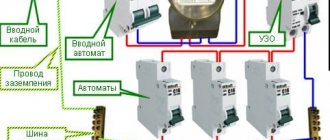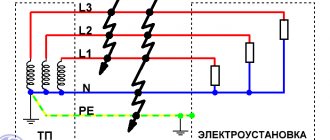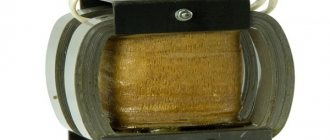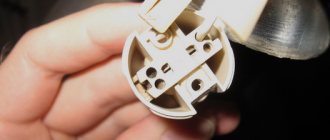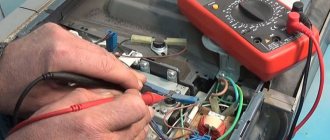Differential automatic
Quite often, a difavtomat is installed in the electrical panel of an apartment or private house.
The reasons why he kicks out are a little more complicated. The fact is that this device combines two protective devices: an RCD and a circuit breaker. Consequently, the reasons that lead to its operation are more extensive and relate to various factors. We discussed above what causes the circuit breaker to turn off. The same reasons influence the automatic device and cause it to operate. But, in addition, the differential device also works as an RCD, therefore, it responds to leakage current, which is somewhat more difficult to find.
Reasons for triggering
Let us analyze the main reasons for the operation of this protective device and possible places where leakage current is generated.
First of all, if the automatic circuit breaker has tripped, you need to inspect it and, if necessary, tighten the contacts
Also, when examining the protective device, pay attention to the wiring in the electrical panel. Perhaps the phase wire lies on a metal casing that is grounded
This will not cause a short circuit, but may cause the machine to kick out.
If everything is normal in the electrical panel, it means that there is a current leak in the circuit that the device protects. This can happen in several places:
- The cause can be any electrical appliance. If it penetrates the body, the difavtomat is guaranteed to turn off: this is one of its main functions, to protect a person from electric shock.
- Perhaps the consequence was the old electrical wiring, or rather, its worn insulation: current leakage gradually appears through microcracks, to which the difavtomat reacts. If the wiring is new, a leak may occur in a poor connection or if the wall is damp, for example due to flooding.
- A common mistake made by inexperienced electricians is shorting the neutral wire with protective grounding. This is strictly prohibited, since it leads to the operation of protective devices such as RCDs or differential devices.
- Damage to the case or sticking of the test button can also cause the device to trigger. In this case, it is necessary to replace the faulty device.
- Weather conditions, namely a strong thunderstorm, often lead to the automatic machine being knocked out. This occurs due to strong atmospheric discharges, which enhance natural current leakage. In this case, you should wait until the storm subsides and then turn on the voltage.
- Unprofessional installation or hastily installed wiring leads to the fact that the electrical connection diagram of the differential device is not followed. This leads to the fact that it periodically knocks out for no apparent reason.
The serviceability of the device must be checked periodically. To do this, when the load is removed, press the “test” button. A working difavtomat should turn off. If the device does not turn off, it does not perform protective functions, and it is better to replace it with a working device.
Methods for detecting a leak
To find the location of the leakage current, after the automatic circuit breaker has tripped, you need to unplug all electrical appliances from the outlets. After this, the protective device is turned on. If the shutdown does not occur again, it means that some device is breaking through to the housing. You can detect it by calling it with a multimeter.
If the differential device continues to knock out, then the problem is in the wiring. It is best to start an inspection of the electrical circuit with socket groups and distribution boxes
Particular attention should be paid to the places of connections and twisting of wires, the integrity of the insulation and the reliability of contacts
After checking all contact groups in the electrical network, proceed to the next stage. It is necessary to check each individual line for current leakage. It is recommended to start from the electrical panel, gradually moving deeper into the house or apartment. Having determined the line or junction box after which the differential current occurs, all twists are disconnected and each wire is tapped.
Thus, there is a circuit where the insulation is damaged. If necessary, change the wiring or isolate the damaged area. Sometimes you have to remove the wire from the wall to do this if the wiring is hidden. But such cases are quite rare: if the electrical wiring is very old, it is better to replace it during repairs or when installing a differential device.
RCD tripping under no-load conditions
Why do ouzo trigger without load? In this case, the reason may be a high degree of wear and tear. It is this factor that causes defects in the insulation of modern electrical equipment. This often happens when using old washing machines and other household appliances. In almost half of all possible cases, actions performed with the socket help neutralize the consequences of the device’s operation. Often it is enough to turn the plug of the device in it. In accordance with the RES standards, immediately after the installation of meters in apartment buildings, similar devices are also installed, with corresponding response indicators.
RCD after disconnection
Finding the area where the leak occurred is the action that needs to be performed when determining why the ouzo is leaking. Where to begin?
- Turning off all devices in the room
- Studying the wiring - this option should be considered if the devices are functioning properly.
- If the wiring is installed correctly and there is no damage, then solving the problem of finding the right area becomes much easier. The same can be said about those cases when the wiring is divided into several groups and has appropriate protection
- Deactivation of machines, their restart. The equipment should be started one at a time. This is how you can identify the group that is not working properly.
It happens that insufficiently qualified electricians try to connect zero and ground, thus trying to provide protection against current
It is important to note that such actions are prohibited
Checking the RCD in the electrical panel
It is important to emphasize that the RCD does not perform short circuit protection functions. It also does not protect against overcurrents. All the device can do is respond in time to the conditions in which the leak occurred
All the device can do is respond in time to the conditions in which the leak occurred.
How to provide electrical equipment with overload protection:
- Immediately after the RCD, a machine with the required rating is installed
- Differentiated type equipment is installed.
The differentiated type machine is a universal device. It combines the functions of a conventional circuit breaker and a residual current device.
The machine in the dashboard constantly knocks out
Quite often, owners of private country houses and apartments wonder why the machine in the control panel is knocked out without a load, in the absence of visible reasons. In addition to the factors already discussed, a similar situation often arises due to overloads in the electrical outlet network.
When drawing up a project and installing electrical wiring, it is impossible to determine with absolute accuracy the degree of load on each group of sockets. Usually there is a separate circuit breaker for 3-4 sockets. However, if there is a powerful protective device, the rated current of the connected sockets can be significantly lower.
In such a situation, an overload will certainly occur, especially if an iron, stove, microwave and other powerful equipment are simultaneously connected to the same group of outlets. As a result, the circuit breaker inevitably trips. It is possible to eliminate such cases by evenly distributing the powerful load between several outlet groups. If this is not possible, you should not connect several high-power consumers to the electrical network at once.
Sometimes it happens that the machine is knocked out and does not turn back on. Here the reason may be the thermal release, which gets very hot. To turn the device back on, just let it cool down and it will work normally again. The machine is often triggered by a faulty device that consumes increased current. As a result, the network is overloaded and the circuit breaker is knocked out. The solution to the problem, as already noted, is to turn on the devices one by one until the faulty one is discovered among them.
It happens that the machine itself is not connected correctly. Cores that are loosely tightened in the terminals lead to heating of this place and the operation of the thermal release. The reason is visible to the naked eye when not only the wire insulation becomes burnt, but also the body of the device.
This is interesting: Choosing a circuit breaker - consider the question
Fault detection algorithm
In order to prevent the development of a tragic situation, you need to properly respond to the protection being triggered and know the algorithm for identifying the cause of the automatic shutdown. It is necessary to clearly know the reasons why the machine in the dashboard is knocked out in order to react properly.
Without going into the electrical details of the processes at this stage, we can identify several main reasons for the protection to operate:
- There is a fault in the circuit breaker itself;
- Problems in the machine connection system;
- Instant network overload (short circuit);
- Network congestion that continues for a long time.
It is in this order that it is necessary to find out the reasons for the frequent knocking out of an automatic machine without obvious signs of a short circuit (SC) or prolonged overload, consistently making sure that there are no factors prompting the reaction of the protection system.
A simple protection system in a regular apartment panel
Possible network and equipment problems related to each item on the list will be described below. After making sure that there are no problems described above, you can move on to the next point.
Identifying a faulty machine
In case of frequent operation of the circuit breaker for no apparent reason, you need to start troubleshooting from the switchboard and the protection devices themselves. This test is the least labor-intensive, and problems are often identified at this stage.
A faulty circuit breaker can be detected without purchasing a new device and replacing it - it is enough to have circuit breakers connected to the panel with similar parameters.
Swap machines of equal power without changing the location of jumpers and wires
If a certain machine often breaks, then to check it, you need to connect the group of users served by this device to an adjacent similar machine, and connect the freed wires from the line next door to this circuit breaker (swap the lines).
With this switching, a common cause of machine knockouts is automatically eliminated - loose contacts can become very hot, and the heat from them will be transferred to the bimetallic plate of the device, causing its false operation. By tightening the contact terminals, this cause of operation can be eliminated even without the knowledge of the technician. This nuance also needs to be kept in mind.
Poor contact not only causes false alarms, but can also completely damage the machine.
Due to the curvature of the case, a mechanical defect in the machine is possible, and it can be triggered by vibration. When disconnecting the wires and reconnecting a defective circuit breaker, the mechanical tension in the body can be removed, which will cause confusion for the technician due to the spontaneous elimination of the problem.
Tightening the contacts can relieve mechanical stress in the machine body
If another, working machine operates on a switched group of users, you should look for the cause in the electrical wiring. If on a new line the same machine frequently operates in the same way, then it will definitely need to be replaced or repaired.
Replacing a faulty machine
Reasons for machine wear
Despite the fact that circuit breakers are not dismountable by definition, folk craftsmen have learned to disassemble and repair them. Having drilled out the rivets using a drill, the machine body can be disassembled.
To disassemble the machine you will need a drill
Burnt contacts have a higher contact resistance, as a result of which they overheat, and the heat transfers to the bimetallic plate, causing it to deform and turn off the current.
Disassembled circuit breaker
Basic cleaning of burnt circuit breaker contacts can extend the life of the circuit breaker and prevent further false alarms. It must be remembered that contact burning occurs when the machine is turned on while all electrical appliances are connected to the network, that is, under load.
How to extend the life of a circuit breaker
Remember two tips:
- Do not overload the protected line with a current higher than the rated current.
- Do not turn off the machine under load.
If everything is clear with the first tip, then the second one is a little more complicated. When current flows through the contacts and you are about to separate them, an arc occurs. This happens due to the truth of the laws of commutation: “The current in the inductance cannot stop instantly.”
Even if the load is active, for example a heater, the cables have their own parasitic inductance. It is even more dangerous to open a circuit breaker if a load such as electric motors or lighting networks with a large number of chokes (DRL, DNAT, LL) is connected to it - the inductance is even greater, and so is the arc. Hence contact defects, their charring, accelerated wear and sticking.
We have become familiar with what defect is caused by what. Circuit breakers last quite a long time if they operate within rated conditions. Modern machines cannot be repaired, so we do not recommend disassembling them; it is better to replace them with a high-quality analogue, for example Moeller or ABB. For household appliances and active loads, use machines with the letter B; to connect a load with significant starting currents (motor), devices with the letter D are better suited, and the number after the letter indicates the amount of permissible current. Avoid connecting oxidized wires and always tighten terminals. By adhering to these tips, circuit breaker malfunctions will occur much less frequently, and you will not have to worry about the safety of the wiring in your apartment or house.
Finally, we recommend watching a useful video on the topic:
You probably don't know:
- Socket malfunctions and ways to eliminate them
- How to find a short circuit in wiring
- Reasons for triggering the automatic device
- How to check the performance of an RCD
Published: 01/27/2018 Updated: 01/31/2018
Short circuit in old wiring: why does the machine not work and how to fix it?
A fuse must be installed on every cable and wire with a voltage of 220 or 380 Volts.
- in case too much current flows through the wire.
The conductors can pass a certain amperage, and if it is exceeded, they will begin to overheat
and may even catch fire.
In old wiring
, the short circuit current may not be very large due to the high resistance of old wires, unreliable connections and the old substation.
about what this means
in our article: it’s
important to know
!
What does short circuit current depend on?
Take a look at the diagram
higher.
It shows that during a short circuit, electric current passes through the circuit
starting from the winding of the transformer at the substation, through the overhead lines, the switchboard and finally the wiring in the house or apartment.
The resistances
of all these sections
add up
and the higher the total resistance, the correspondingly
the short circuit current will be
In new
in houses with a recently installed substation, the short-circuit current can reach
several hundred
or even
thousands
of amperes, but in old ones it can easily be below 100 amperes.
You will say: this is good, the lower the current, the less the danger! In general, this is true
, but at low current
another threat
-
the circuit breaker not work
At what current does the machine operate?
The situation here is twofold
.
On the one hand, the machine has a thermal breaker
, which is triggered by a small current - for example, 20 amperes.
But it is slow
- it may take several seconds for it to operate, and if there is a short circuit, the wires may catch fire during this time.
With another
- all modern machines have an “
instant
” circuit breaker that disconnects the line at the speed of sound.
One problem is that it triggers at high current
.
For example, for a machine with a “C” characteristic and a rating of 16 Amps, the electromagnetic circuit breaker will operate at a current of 80
to
160 Amps
- no one knows for sure.
If the short-circuit current is less than 80 amperes, which is possible in old wiring, only the slow
circuit breaker will operate, and this threatens a fire.
What is “machine B” and why is it better to use it?
To protect old wiring, you need to install not ordinary machines, which are sold everywhere, with the “C” characteristic, but sensitive
- with
characteristic “B”
.
Their fast release current is much lower and guaranteed
to work even with weak short-circuit currents. One problem is that they are not often on sale, so you will have to
order
, but it’s worth it!
As a general machine
It’s better to leave the device with the usual letter “C” - it will provide additional protection, “just in case.”
What not to do if the machine turns off
If the plugs are out, you shouldn’t try to get into the dashboard yourself, you need to figure out the reason
You should not climb into the electrical panel yourself if the plugs in the apartment are knocked out. It is necessary to understand the reasons. If there is no light in the entire entrance or in neighboring houses, most likely there is a problem at the substation. All household appliances must be unplugged from their outlets so that they do not burn out when power is restored in the event of a power surge.
When the problem affects only one apartment, you need to open the flap and see which of the plugs has worked. The white button will protrude a few mm from the housing. When you press it, the fuse turns on.
Modern circuit breakers are installed on new construction sites. If the pedals of the device are lowered, it means that the plugs are knocked out. To restore electricity in the apartment, just move the lever to the upper position.
Sometimes people consider constant power outages to be the norm and do not think about the wear and tear on the circuit breaker. Sooner or later the button gets stuck and the device stops functioning in the correct mode. Due to excess voltage, an emergency situation occurs, which in most cases leads to a fire.
Troubleshooting
If the differential circuit breaker has tripped, you can try to turn it on again. This will eliminate the possibility of triggering during a power surge. If the attempt is unsuccessful, then you need to disconnect the consumer from the outlet controlled by the automatic device and try to turn it on again. Did you manage to turn it on? This means the problem is consumer isolation.
In the case when the attempt is unsuccessful and the device works as before, you need to look for the reason further. Now you can unscrew the outgoing wires L and N from the device and thus check its functionality, without load. A working device should turn on and operate when you press the “TEST” button.
The algorithm for searching for the reason for the operation of the differential machine is shown in the diagram:
We also recommend watching a video that clearly demonstrates common errors when connecting differential protection, which results in the device being knocked out:
So we looked at the main reasons why the automatic switch in the dashboard works. We hope you now know what to do to solve the problem!
Be sure to read:
- Errors when installing electrical wiring
- Why does a circuit breaker trip?
- Reasons for tripping the RCD in the panel
- How to connect a difavtomat
Disassembling the light switch
To repair a switch, you must first disassemble it. Let's get to work. Even though you have already turned off the power supply, check the voltage level using a multimeter. If you do not have such a device, use an indicator screwdriver, which you can purchase at your local hardware or electrical supply store.
Two-gang switch
- When starting to solve the problem of repairing a light switch, arm yourself with a thin screwdriver or knife in order to pry and remove the buttons, as well as the decorative cover of the switch from a special plastic box (socket box). New models usually have a recess to make it easier to lift the lid. Then you need to unscrew the screws located under the buttons. Don't forget to carefully place them in the prepared container.
- Remove the switch from the wall by unscrewing the fasteners, not forgetting to mark its position on the wall. Fastening elements may be different, depending on the material from which the wall is made.
- With a marker, mark the main wire attached to the main terminal, which is responsible for the voltage.
Troubleshooting network problems
Having previously found out why the RCD is triggered, it becomes easier to specify the problem. So, if the problem is poor-quality installation, then you should disassemble the entire line and reconnect all phases, guided by a special diagram. In cases where the RCD has tripped and does not turn back on even when the circuit breakers are lowered, the protective equipment will have to be completely replaced.
The search for the “culprit” can be done in two ways:
Visually inspect each device, try to identify signs of malfunction (inoperability, charred wires, damage to the case, cord or plug, unpleasant odour).
Connect each unit to the network one by one, observing the reaction of the RCD, which will trip again when the faulty device is connected.
The reason why the RCD trips without load is faulty wiring. This outcome is the most time-consuming and energy-consuming to eliminate a possible problem. Before completely replacing the line with a new one, try the following:
- Carry out a thorough inspection of all sockets, switches, distribution boxes and panels for the “zero” to come off, the core to be exposed and moisture to enter.
- Check to see if the overhead light is the culprit.
An RCD is a guarantee of our safety, therefore, when it is triggered, it is necessary to inspect all electrical wiring, and if a problem is identified, immediately eliminate it to avoid recurrence.
Features of the circuit breaker
To understand the reasons for the operation of a circuit breaker, you must first answer the question of what this device is for and what functions it performs. Features of AV operation are as follows:
- The AV can de-energize the network both when switched off manually and when an emergency occurs, which can lead to damage to circuit elements.
Why does the protection work?
There are only three reasons why a traffic jam can be knocked out:
- Short circuit;
- Excessive load;
- Damage to the device itself.
The most dangerous reason is a short circuit, which can be triggered by a weakened or melted insulating sheath of wires, water getting into them, or a burnt electrical appliance.
With such an outcome, a sharp jump in current occurs in the network, the wiring heats up, and the voltage quickly drops, and traffic jams detect the emergency and automatically de-energize the network. Otherwise, a fire or wiring will burn out.
If plugs in the meter often break out without dire consequences, then the reason lies in the network overvoltage. By connecting several devices to one branch at once, you risk exceeding the permissible rating, which for a machine is 16 amperes, and for one plug is no more than 2.5 kW.
It is not often that a knocked-out plug signals a malfunction, because, like any device, it can simply fail and turn off falsely. Also, a sudden breakdown of a large household appliance triggers the protection mechanism.
What are electrical plugs?
There are two types of electrical plugs:
When a plug with a fuse link trips, you will need to change the fuse link on a special fuse located inside the electrical plug. In the fuse that you are going to replace the burnt one, its characteristics play an important role: they must exactly repeat the characteristics of the one being replaced.
You need to look at such a parameter as the rated current. If you install a fuse with an overrated current, then in the event of a short circuit the protective mechanism will not work, the network will not be de-energized, and as a result, the electrical wiring will most likely burn out somewhere, troubleshooting which is quite difficult if it is walled up in the wall.
The main thing is prevention
In conclusion, let's look at how the electrical wiring in the apartment should be arranged so that machines and traffic jams are knocked out as rarely as possible. The main thing here is to turn on the protective automatics for the sake of pennies of savings only in the break of the phase wire, as on the right in Fig. - a grave mistake.
Correct and incorrect inclusion of protective automation in apartment electrical wiring
Firstly, in some emergency situations on a network with a solidly grounded neutral, phase voltage may appear on the neutral wire; what this entails – see above. Secondly, such inclusion does not guarantee against problems with electricians: if the wiring neutral is solid, then there are ways to steal electricity. Let someone else do this, but the dispatcher will notice, and it will be up to you to prove to the inspector that the camel is not you.
Any automatic protective equipment must break all suitable conductors when triggered (in networks with a solidly grounded neutral - 2, phase and zero), this is the first thing. And secondly, all potentially emergency devices and devices must be turned on each through their own current protection circuit breaker, on the left in Fig. If you live in an apartment building, for which it is not possible to install a protective grounding circuit, these rules must be strictly followed.
Display all materials with the tag:
Go to section:
Reasons why a circuit breaker trips
There may be several such factors; we will look at each of them in detail.
Permissible load exceeded
Each machine has its own characteristics, which are reflected on its body. One of these indicators is the rated current that the device can carry. If this current is exceeded, after a while the machine is knocked out: this is an automatic thermal release that has tripped to protect the electrical wiring.
There are two ways to solve this problem:
- The easiest way (and the most recommended by electricians) is to alternately connect electrical appliances to the network to avoid overloads. For example, if you have a 16A machine installed, it can “withstand” a load of 3.5 kW;
- You can replace the circuit breaker with a more powerful one, for example, install the device at 25A. The machine no longer knocks out, since it is designed for a load of 5.5 kW. But this method of solving the problem is used only if the old wiring has been replaced with a stronger cross-section (minimum 2.5 square meters for copper conductors).
Note! If an overload shutdown occurs, it will be possible to restart the machine only after some time, when the thermal release has cooled down
A short circuit has occurred
Another common reason why a machine breaks down is a short circuit. A short circuit can occur due to several factors and in different places. Let's look at this issue in detail.
Short circuits in electrical appliances are very easy to detect. Usually, if there is a short circuit in any electrical appliance, it stops working. Also an indicator is a blackened case or melted wires. In this case, it is enough to disconnect the device from the network and turn on the machine, it will not knock out.
If there are no obvious signs of a short circuit, you should turn off all electrical appliances. After turning on the voltage, turn on the consumers one by one. When a closed device is plugged into the network, the machine will trip again or it will be discovered that the consumer is faulty.
If everything is fine, try turning on the lights in each room. It happens that the socket or light bulb shorts out, so it knocks out the protection.
Short circuit in electrical wiring
If the above steps did not detect a short circuit, it may be in the wiring. Finding the location of a short circuit in the wiring, especially if it is hidden, will be much more difficult. To do this, you need to ring each line with a multimeter. But first, you can check the distribution boxes and sockets. It is in these places that short circuits most often occur.
When checking distribution boxes and sockets, you should first of all pay attention to melted wiring, exposed ends or loose contacts. Such shortcomings need to be eliminated: the ends are securely insulated, and all contacts are tightened
The circuit breaker has failed
You shouldn’t rule out the situation when the machine itself is out of order, this also happens. The reason for this may be a manufacturing defect in the design or mechanical damage to the housing. There are times when you just need to tighten the contacts on the device itself, which have become loose over time. If this does not help, replace the machine with a similar rated current. This is quite easy to do and won't take much time. If the shutdowns stop, it means that the cause was found and eliminated.
These are, perhaps, all the factors that lead to the circuit breaker tripping. There are not very many of them, but any one can cause a shutdown. Let us remind you that if the protection has been triggered, in order to avoid more serious consequences, you should not postpone the inspection of the electrical network until later.
The main problems with automatic machines
The machine has only three main faults:
- Knocks it out.
- Doesn't turn off.
- Doesn't cock.
The machine knocks out - this means that either suddenly, without obvious reasons, the voltage disappears, or when you turn on the load in one of the circuits, the power supply network is turned off. The machine may also not turn on in different ways:
- When the lever is cocked, it immediately goes down, the voltage appears briefly or does not appear at all.
- The lever is jammed and does not cock and does not work at all.
- If you hear a burning smell or the wires are burnt out from the circuit breaker, you need to turn it off before starting the repair, but the lever simply does not budge, as described in the previous paragraph, only in the on position.
The machine kicks out for no apparent reason
Periodic tripping of a circuit breaker is associated with the operation of a thermal disconnector or voltage surges in the supply network. There is nothing you can do about the last reason, except perhaps install a voltage stabilizer at the input to the machine, but this is expensive. But shutdown via a thermal disconnector is associated with a long-term but insignificant excess of the rated current.
More often than not, this is not a faulty circuit breaker, but rather a misuse of the circuit breaker. First of all, you should find out what current it is designed for, this is written on the front panel. Then calculate the total current consumed by electrical appliances that are powered through it. If the current is not indicated on the devices, the power consumption should appear on them; in this case, divide the number of W by 220 V, then you will find out the number of Amperes through the machine.
If the result obtained exceeds the nominal value of the machine, it will open. If the machine hums or crackles, this is a sign that it is overloaded.
Solution: Reduce power line consumption, turn on powerful devices one at a time.
If the rating of the circuit breaker is selected correctly, the matter is different. The thermal disconnector is also thermal, so that it opens when overheated, and the source of heat can be burnt power contacts (as in the photo below) or wires that are not tightened in the terminal blocks. Both lead to an increase in contact resistance and heating, since the case is closed, there is nowhere for the heat to go, the thermal protection plate gradually heats up, and over time it will open.
Solution: Check the tightness of the wires, remove them, if necessary, clean them from oxidation and carbon deposits, and then retighten them. The contacts cannot be cleaned without disassembling the machine; it is better not to “treat” this malfunction, but to replace the circuit breaker. To disassemble it, you can drill out the rivets and open the body, but you risk not assembling it or assembling it with errors, with distortion and mechanical defects, which will complicate correct operation.
Overheating can also occur from heat sources located near the AV in the shield itself. Check the temperatures of the surrounding devices with your hand; something nearby may be heating up.
Trigger when load is turned on
If a malfunction occurs when one of the circuits is turned on, for example a light, the fault is most likely in the lamp or the wiring leading to it. A short circuit has occurred due to the integrity of the cable insulation or connections being damaged.
Solution: Diagnostics and repair consists of disconnecting the main line cable and replacing it with a temporary one; if it helps, then you have to inspect and repair the wiring.
Instant shutdown of the machine is associated with the operation of electromagnetic protection. It does not lock in the on position due to internal problems with the same electromagnetic protection. You can check the serviceability of the machine by replacing it with a known good one, with the same rated current and sensitivity - if everything works properly, this is the reason. If the circuit breaker does not reset without voltage, and there is no short circuit, it needs to be replaced.
Circuit breaker does not turn on
If you lift the lever up, but the circuit breaker does not turn on, and the lever instantly falls down, this is due to either mechanical wear of the machine components or the presence of a short circuit. You can check this by ringing the supply phase to zero with a low-resistance tester, for example, a test light, or an ohmmeter. High-impedance continuity testing (for example, LED control) can mislead you and the circuit can ring through the load (light bulbs, heating elements or electric motors). If the circuit is closed, then there is a breakdown of the cable insulation.
Solution: Troubleshoot the problem by replacing the cable or restoring the insulation. If there is no short circuit, then replace the machine.
The lever is jammed
It’s another matter when you cannot move the machine lever from the lower position, which means the contact drive mechanism is jammed. This malfunction can occur when switching off under load, if a strong arc occurs and its splashes jam the movable contact, or rather its components, or it is soldered into the housing.
Checking the circuit breaker
Do a basic check of the circuit breaker.
- Turn off the power supply to the apartment panel;
- Turn off all circuit breakers;
- Click the circuit breaker charging lever. It should turn on and off with a characteristic “click” sound.
- If a click is not heard, the machine is faulty and requires replacement.
- If there is a click, use a measuring device to measure the resistance between the terminals of the circuit breaker. When "on" machine resistance should be close to zero. When "off" The resistance of the machine should be close to infinity.
Generally speaking, factory failure of circuit breakers is not that uncommon and the choice of circuit breaker is important. What can we say about the malfunctions of machines that arise during operation?
A malfunction of the circuit breaker itself cannot be ruled out as the main reason for its periodic shutdown.
Installing a circuit breaker is a simple matter, and such a replacement can save you from major work to find other electrical faults in the apartment.
Ehto.ru
What to do?
First of all, determine which circuit breaker tripped in the electrical panel. If this is only a general circuit breaker, then a short circuit has occurred directly in the electrical panel. Upon careful inspection, this will be noticeable, and you will also smell the smell of burnt plastic. If you have the skills, you can begin to repair the damage, otherwise you need to call a specialist.
When any linear circuit breaker (line of sockets or lighting) is triggered, you need to look for a fault specifically on the disconnected line.
Line of sockets. We remove all plugs of electrical appliances from the sockets and try to turn on the machine. If the machine does not turn off, then the problem is a breakdown of one of the devices - electricity consumers. Finding it is not difficult - plug the devices into the sockets one by one and the circuit breaker will “knock out” when the faulty device is connected. If it “knocks out” when all electrical receivers are turned off, the problem is due to damage to the electrical wiring. Then you need to look for a fault in sockets and distribution boxes - tighten the internal contacts first. If this does not lead to anything, then we disconnect the wires in the boxes and “call” them with a multimeter for the fact of a short circuit. This way you can understand which wire or cable needs to be replaced.
Lighting line. A similar principle of action in this case is to de-energize all lighting equipment on the line. If the machine turns on, then the fault is in one of the lamps. We turn on each of the lamps one by one, thus finding the faulty one. If we find it, we inspect the contacts in the electrical socket and begin to repair it. If the machine does not turn on even when the lamps are turned off, then the electrical wiring must be repaired (the problem must be looked for in the same way as in the case of a line of sockets).
Exceeding the rated current of the machine
If the permissible current of the switch is exceeded, the thermal release, heating up, will disconnect the contacts of the machine from the power supply. The shutdown time depends on the current value. For old electrical wiring, a 16 A automatic machine is installed.
For a new one, with copper wires and a cross-section of 2.5 mm², install a 25 A switch. To circumvent the cause of the overload, when the machine in the panel knocks out, you need to turn on all electrical appliances and lighting so as not to exceed the rated current of the machine.
If you need to turn on different electrical appliances with a total power higher than the permissible load of the circuit breaker, then you need to use a priority relay. After turning off the machine, you need to wait some time for the bimetallic plate of the thermal release to cool down, otherwise the machine will not turn on.
AV is out of order: what to do if the plugs are knocked out
Another reason for the machine to operate is a short circuit in the electrical wiring. If the fuse has tripped due to a short circuit, you need to look for the cause. There is an effect on the phase, which in some place touches the zero, because of this a short circuit occurs and the AB protects and is instantly triggered. If electrical appliances are unplugged from the sockets and the plugs are knocked out, it is necessary to completely check the electrical wiring. This takes quite a long period of time and, in addition, you need to have the skills to find a fault, or maybe two at once. The first thing you need to do is examine all sockets and switches and check the quality of the TPG connections to the terminals. If the electrical wires are loose, the screws should be tightened.
After the sockets, you need to study the distributors. Understand that the connection of the electrical wires in them is normal, there are no bare spots that could short out. After the boxes, you need to check the lighting devices. Very often, inexperienced electricians forget to check the chandelier after the AV trips without a load. After this the light bulb burns out. It is necessary to check the reliability of the connections, as in the situation with sockets. Finally, you need to check the electrical wiring, which is usually hidden in the wall. In this case, it is correct to use a special device that will help quickly detect a short circuit. But hardly anyone at home will have it on hand, so a multimeter will help get out of the situation. Here are the reasons that turn off an electric machine and how to eliminate them.
The most rare reason, which can be the same, is a low-quality MTA machine, which kicks out due to a manufacturing defect.
You should check the machine if you are 100% sure that:
- Electrical appliances are in good working order;
- Electrical wiring is OK;
- There is no talk of overloads.
Replacing the machine with a similar one will help correct the situation; you can also replace the electric meter. This will definitely solve the problem. To avoid such a situation in the future, electricians are advised to get acquainted with the rating of the best brands of circuit breakers and select one circuit breaker and a meter from the list. It’s also a good idea to read consumer reviews. In addition to the listed reasons why the AV switched off in the electrical panel, there are also other, rare situations.
Restoring rotary and touch models
Touch switches must be repaired in specialized workshops. In rotary-type devices, characteristic malfunctions have approximately the same causes and manifestations as in keyboard analogues. In their working mechanism, the closing and breaking contacts also burn out and completely wear out, which is explained by their intensive use. In addition, by analogy with the samples already considered, it is also possible for them to loosen the contacts at the points where the phase conductors are connected.
Restoring switches of this class is similar to the approach already discussed for key products. Difficulties arise when the cam mechanism breaks down, which is unlikely to be repaired manually. In this case, experts advise completely replacing the device with a new product.

